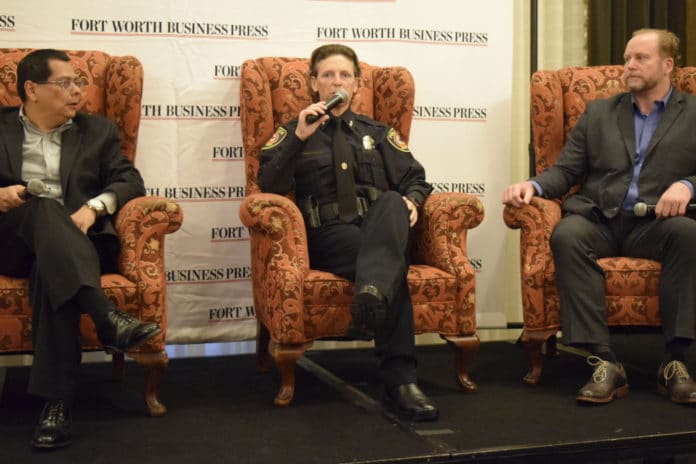The Fort Worth Business Press held a Business for Breakfast panel on Oct. 31 on the topic of Workplace Violence and Active Shooters
The event was held at the Fort Worth Club. Co-presenting sponsors were JTaylor and Pinnacle Bank. The gold sponsor was HUB.
Panelists were Drew Bowman, vice president and senior risk consultant of organizational resilience at HUB International; Ty M. Sheaks, a partner with McCathern PLLC; C. Leigh Dietrich, assistant chief of police at Tarrant County College District; and Edward Rivas, regional manager of kidnap and ransom, active shooter and workplace violence division at AIG.
Here are some excerpts from the discussion.
Leigh Dietrich, TCCD: I put a great deal of importance on training and education just on the active shooter response. Obviously, all of our officers are trained to respond. This to me is one of the most important aspects because our police officers can’t be everywhere all the time and a frequent question I get is, “What can I, as a faculty member or a staff member or a student, what can I do in any type of a critical incident?” We provide training across the district for our faculty, our staff and our students. We utilize a program CRASE, which is an acronym for Civilian Response to Active Shooter Events. We provide that for anybody that is willing to show up and take our class. Our police officers are trained to teach that.
…The last thing I would add is we don’t just train our folks on what to do at TCC. It’s what to do if you’re in Walmart. It’s what to do if you’re sitting here at this event. It’s what to do if you’re sitting with your family at home. I think that’s a very good thing. We don’t want people to be compartmentalized in their reactions.
Edward Rivas, AIG: I’ll just jump in real quick on that too. For training purposes, there is a lot publicly available and free. It’s great that you go take the class, but there is a lot of resources available. I think one of the best five minutes you can have any of your employees, your family, anyone spend is watch RUN. HIDE. FIGHT, a video by the City of Houston Police Department. They put that together several years ago. That’s probably the standard. You can YouTube these things. They’re out there.
Drew Bowman, HUB: One of the things that I’ve found going across the United States is that the majority of people want to be told what to do and not how to think about the situation. For instance, I’ll ask, Who here, everybody here, what are the construction of these walls right now in the event that we have to kick our way out … in order to get to a different type of room because there was controlled gunfire out there?
Can you go to the bathroom here and lock yourself in? Has anybody checked to see if everything locks? … Going into facilities and understanding where we are in the relationship to where we came in and how to get out of those things?
Because a lot of the information is really good. ,,, Because if you just run wildly, you’re not running to safety, you’re running from something. The likelihood of you getting into the next hassle begins then.
Three things I’ll break this down to are: Almost every discussion I had is about leadership, communications and compact problem-solving because these are complex human issues that we run into. You have to out-think them, not to just respond.
This you have to plan as managers, for people that do all three of these, because people are going to do that based upon context and relevance to their experience. The training is good but it has to be a brief course and mostly, by the way, you think about the problem solving.
Rivas: I think you’re right, Drew, in that remark because one of the questions we get when we do planning with our clientele is, especially the charter schools, universities and independent school districts as well, is all the students and faculty are supposed to, let’s say, go to the parking lot or the football field. If one of the perpetrators is going to be a student, then they know where they are going and are coming back. Is what you said, Drew, is you have to train complex thinking to think about what you’re doing? [In a shooting that occurred] in Washington, D.C,, the gunman knew to block the back exits.
So when everybody heard the gunfire they all ran to the back and the door was closed, but instead of doing something different like going to the windows or a fire escape, they all bunched up at the door and didn’t know what to do. That’s when the majority of the fatalities happened in that case.
… There is a lot of information on the internet. As anything on the internet, some of it’s very good, some of it may be a little bit more self-serving than necessarily helpful.
Ty M. Sheaks, McCathern: I really want to make a point that whether you’re a huge corporation who can afford to hire consultants and have an internal HR team, all that stuff, or you’re just a mom-and-pop restaurant, at least having these conversations and knowing that this stuff is out there, having a plan and working that plan is the most important part of this.
You could just be a small shop and have your own written policy procedure to include to do something about work assignments and have a zero-tolerance policy. How do you handle that? You can talk with your five employees that you have at your company, or if you’re a big company, you’ve got an HR department. Have your HR department talk to your thousands of employees. I highly recommend that whatever you have in place, you make sure you follow it.






